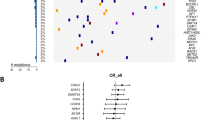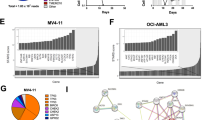Abstract
Acute myeloid leukemias (AML) with mutations in the NPM1 gene (NPM1c+) represent a large AML subgroup with varying response to conventional treatment, highlighting the need to develop targeted therapeutic strategies for this disease. We screened a library of clinical drugs on a cohort of primary human AML specimens and identified the BCL2 inhibitor ABT-199 as a selective agent against NPM1c+ AML. Mutational analysis of ABT-199-sensitive and -resistant specimens identified mutations in NPM1, RAD21, and IDH1/IDH2 as predictors of ABT-199 sensitivity. Comparative transcriptome analysis further uncovered BCL2A1 as a potential mediator of ABT-199 resistance in AML. In line with our observation that RAD21 mutation confers sensitivity to ABT-199, we provide functional evidence that reducing RAD21 levels can sensitize AML cells to BCL2 inhibition. Moreover, we demonstrate that ABT-199 is able to produce selective anti-AML activity in vivo toward AML with mutations associated with compound sensitivity in PDX models. Overall, this study delineates the contribution of several genetic events to the response to ABT-199 and provides a rationale for the development of targeted therapies for NPM1c+ AML.
This is a preview of subscription content, access via your institution
Access options
Subscribe to this journal
Receive 12 print issues and online access
$259.00 per year
only $21.58 per issue
Buy this article
- Purchase on Springer Link
- Instant access to full article PDF
Prices may be subject to local taxes which are calculated during checkout





Similar content being viewed by others
References
Longo DL, et al. Acute myeloid leukemia. New En J Med. 2015.
Arber DA, et al. The 2016 revision to the World Health Organization classification of myeloid neoplasms and acute leukemia. Blood. 2016;127:2391–405.
Döhner H, et al. Diagnosis and management of AML in adults: 2017 ELN recommendations from an international expert panel. Blood. 2017;129:424–47.
Schlenk RF, et al. Mutations and treatment outcome in cytogenetically normal acute myeloid leukemia. New Engl J Med. 2008;358:1909–18.
Papaemmanuil E, et al. Genomic classification and prognosis in acute myeloid leukemia. N Engl J Med. 2016;374:2209–21.
Saygin C, Carraway HE. Emerging therapies for acute myeloid leukemia. J Hematol Oncol. 2017;10:93.
Garnett MJ, et al. Systematic identification of genomic markers of drug sensitivity in cancer cells. Nature. 2012;483:570–5.
Pabst C, et al. Identification of small molecules that support human leukemia stem cell activity ex vivo. Nat Methods. 2014;11:436–42.
Simon L, et al. Chemogenomic landscape of RUNX1-mutated AML reveals importance of RUNX1 allele dosage in genetics and glucocorticoid sensitivity. Clin Cancer Res : Off J Am Assoc Cancer Res. 2017;23:6969–81.
Falini B, et al. Acute myeloid leukemia carrying cytoplasmic/mutated nucleophosmin (NPMc+ AML): biologic and clinical features. Blood. 2007;109:874–85.
Versluis J, et al. Comparative value of post-remission treatment in cytogenetically normal AML subclassified by NPM1 and FLT3-ITD allelic ratio. Leukemia. 2017;31:26–33.
Souers AJ, et al. ABT-199, a potent and selective BCL-2 inhibitor, achieves antitumor activity while sparing platelets. Nat Med. 2013;19:202–8.
Robertson LE, et al. Bcl-2 expression in chronic lymphocytic leukemia and its correlation with the induction of apoptosis and clinical outcome. Leukemia. 1996;10:456–9.
Konopleva M, et al. Efficacy and biological correlates of response in a phase II study of venetoclax monotherapy in patients with acute myelogenous leukemia. Cancer Discov. 2016;6:1106–17.
Maiga A, et al. Transcriptome analysis of G protein-coupled receptors in distinct genetic subgroups of acute myeloid leukemia: identification of potential disease-specific targets. Blood Cancer J. 2016;6.
Rose D, et al. Subtype-specific patterns of molecular mutations in acute myeloid leukemia. Leukemia. 2017;31:11–7.
Thiede C, et al. Prevalence and prognostic impact of NPM1 mutations in 1485 adult patients with acute myeloid leukemia (AML). Blood. 2006;107:4011–20.
Fresquet V, et al. Acquired mutations in BCL2 family proteins conferring resistance to the BH3 mimetic ABT-199 in lymphoma. Blood. 2014;123:4111–9.
Network C, et al. Genomic and epigenomic landscapes of adult de novo acute myeloid leukemia. New Engl J Med. 2013;368:2059–74.
Pati D, Zhang N, Plon SE. Linking sister chromatid cohesion and apoptosis: role of Rad21. Mol Cell Biol. 2002;22:8267–77.
Atienza JM, et al. Suppression of RAD21 gene expression decreases cell growth and enhances cytotoxicity of etoposide and bleomycin in human breast cancer cells. Mol cancer Ther. 2005;4:361–8.
Li J, et al. Downregulation of SMC1A inhibits growth and increases apoptosis and chemosensitivity of colorectal cancer cells. J Int Med Res. 2016;44:67–74.
Mazumdar C, et al. Leukemia-associated cohesin mutants dominantly enforce stem cell programs and impair human hematopoietic progenitor differentiation. Cell Stem cell. 2015.
Carrington EM, et al. Anti-apoptotic proteins BCL-2, MCL-1 and A1 summate collectively to maintain survival of immune cell populations both in vitro and in vivo. Cell death Differ. 2017;24:878–88.
Esteve-Arenys A, et al. The BET bromodomain inhibitor CPI203 overcomes resistance to ABT-199 (venetoclax) by downregulation of BFL-1/A1 in in vitro and in vivo models of MYC+/BCL2+ double hit lymphoma. Oncogene. 2018.
Bogenberger J, et al. Combined venetoclax and alvocidib in acute myeloid leukemia. Oncotarget. 2017;8:107206–22.
Teh TCC, et al. Enhancing venetoclax activity in acute myeloid leukemia by co-targeting MCL1. Leukemia. 2018;32:303–12.
D de Araujo A, et al. Bicyclic helical peptides as dual inhibitors selective for Bcl2A1 and Mcl-1 proteins. J Med Chem, 2018.
Kotschy A, et al. The MCL1 inhibitor S63845 is tolerable and effective in diverse cancer models. Nature. 2016;538:477–82.
Pan R, et al. Selective BCL-2 inhibition by ABT-199 causes on-target cell death in acute myeloid leukemia. Cancer Discov. 2014;4:362–75.
DiNardo CD, et al. Safety and preliminary efficacy of venetoclax with decitabine or azacitidine in elderly patients with previously untreated acute myeloid leukaemia: a non-randomised, open-label, phase 1b study. Lancet Oncol. 2018;19:216–28.
Chan SM, et al. Isocitrate dehydrogenase 1 and 2 mutations induce BCL-2 dependence in acute myeloid leukemia. Nat Med. 2015;21:178–84.
Acknowledgements
We wish to thank Dr. Andrew H. Wei for careful revision of this manuscript and insightful recommendations, Muriel Draoui for project coordination as well as Mélanie Fréchette and Valérie Blouin-Chagnon for their help with animal care and in vivo studies. We acknowledge the contribution of people from the IRIC core facilities (CF): Marianne Arteau and Raphaëlle Lambert of the Genomics CF for RNA sequencing; Jean Duchaine, Dominic Salois, and Sébastien Guiral of the HTS CF for assay optimization and chemical screen supervision; Danièle Gagné and Gaël Dulude of the Cytometry CF for assistance with flow cytometry acquisition and analysis. We also acknowledge the Banque de Cellules Leucémiques du Québec (BCLQ) for providing characterized AML samples of the Leucegene cohort with special thanks to Claude Rondeau. C. Moison was supported by a CIHR fellowship. C. Thiollier was supported by the Cole Foundation. V-P Lavallée was supported by a Cole Foundation fellowship and by a Vanier Canada Graduate Scholarship. C Labelle was supported by the Faculty of Graduate and Postdoctoral Studies (Université de Montréal). J-F Spinella was supported by an Ivado fellowship. This work was in part supported by a CCSRI impact grant no. 701573 to G Sauvageau. The work was also supported by the Government of Canada through Genome Canada and the Ministère de l'économie, de l'innovation et des exportations du Québec through Génome Québec, with supplementary funds from AmorChem (2012 Large-Scale Applied Research Project Competition in Genomics and Personalized Health grant no. 4524); G Sauvageau, J Hébert, A Marinier, and S Lemieux are co- applicants for this grant. G Sauvageau and J Hébert are recipients of research chairs from the Canada Research Chair program and Industrielle-Alliance (Université de Montréal), respectively. The BCLQ is supported by grants from the Cancer Research Network of the Fonds de recherche du Québec-Santé (FRQS).
Author information
Authors and Affiliations
Contributions
Conception and design: RB, CM, CT, JK, BL, V-PL, JH, GS. Development of methodology: RB, CM, CT, JK, BL, V-PL, TM. Acquisition of data (chemical screen, patients, etc.): RB, CM, CT, JK, JH, GDA, SL, TM, IB. Analysis and interpretation of data: RB, CM, CT, BL, V-PL, CL, GB, J-FS, GDA, S Lavallée, S Lemieux, M-EB, GS. Writing and revision of manuscript: RB, CM, M-EB, BL, V-PL, JH, GS. Specimen banking and characterization: JH, GDA, S. Lavallée. Chemistry support: AM. Study supervision: M-EB, S Lemieux, AM, JH, GS.
Corresponding author
Ethics declarations
Conflict of interest
The authors declare that they have no conflict of interest.
Additional information
Publisher’s note: Springer Nature remains neutral with regard to jurisdictional claims in published maps and institutional affiliations.
Supplementary information
Rights and permissions
About this article
Cite this article
Bisaillon, R., Moison, C., Thiollier, C. et al. Genetic characterization of ABT-199 sensitivity in human AML. Leukemia 34, 63–74 (2020). https://doi.org/10.1038/s41375-019-0485-x
Received:
Revised:
Accepted:
Published:
Issue Date:
DOI: https://doi.org/10.1038/s41375-019-0485-x
This article is cited by
-
DELE1 haploinsufficiency causes resistance to mitochondrial stress-induced apoptosis in monosomy 5/del(5q) AML
Leukemia (2024)
-
Targeting cytohesin-1 suppresses acute myeloid leukemia progression and overcomes resistance to ABT-199
Acta Pharmacologica Sinica (2024)
-
Computational prognostic evaluation of Alzheimer’s drugs from FDA-approved database through structural conformational dynamics and drug repositioning approaches
Scientific Reports (2023)
-
Targeting a mitochondrial E3 ubiquitin ligase complex to overcome AML cell-intrinsic Venetoclax resistance
Leukemia (2023)
-
Transcriptional signatures of the BCL2 family for individualized acute myeloid leukaemia treatment
Genome Medicine (2022)



